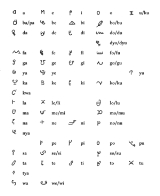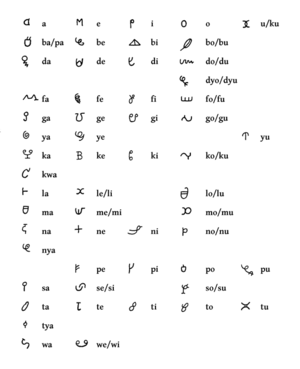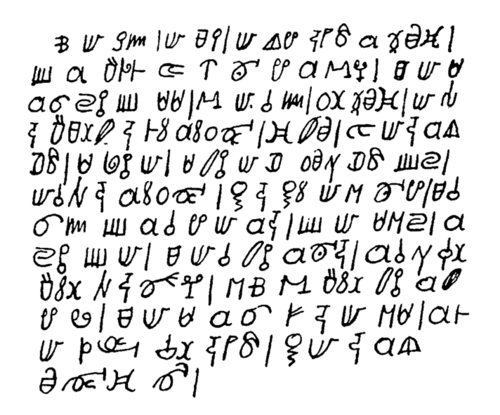
Afaka script
Encyclopedia
The Afaka script is a syllabary
of 56 letters devised in 1910 for the Ndyuka
language, an English-based creole
of Surinam. The script is named after its inventor, Afáka Atumisi. It continues to be used to write Ndyuka in the 21st century, but the literacy rate in that language for all scripts is under 10%.
Afaka is the only script in use that was designed specifically for a creole or for a form of English. It is not supported by Unicode
.
 Afaka is a rather defective script
Afaka is a rather defective script
. Tone
is phonemic
but not written. Final consonants (the nasal [n]) are not written, but long vowels are, by adding a vowel letter. Prenasalized stops and voiced stops are written with the same letters, and syllables with the vowels [u] and [o] are seldom distinguished: The syllables [o]/[u], [po]/[pu], and [to]/[tu] have separate letters, but syllables starting with the consonants [b, d, dy, f, g, l, m, n, s, y] do not. Thus the Afaka rendition of Ndyuka could also be read as Dyoka. In four cases syllables with [e] and [i] are not distinguished (after the consonants [l, m, s, w]); a single letter is used for both [ba] and [pa], and another for both [u] and [ku]. Several consonants have only one glyph assigned to them. These are [ty], which only has a glyph for [tya]; [kw] (also [kp]), which only has [kwa ~ kpa]; [ny], which only has [nya] (though older records report that letter pulled double duty for [nyu]); and [dy], which only has [dyu/dyo]. There are no glyphs assigned specifically to the consonant [gw] ~ [gb]. The result of these conflations is that the only syllables for which there is no ambiguity (except for tone) are those beginning with the consonant [t].
There is a single punctuation mark, the pipe (|), which corresponds to a comma and period. Afaka used spaces between words, but not all writers have continued to do so.
rebus
es, with many of these being symbols from Africa. Examples of rebuses include a curl with a dot in it representing a baby in the belly (in Ndyuka, a abi beli, lit. "she has belly", means "she's pregnant"), and which stands for [be]; two hands outstretched to give stand for [gi]; symbols for come (Ndyuka kom) and go to represent [ko] and [go]; two linked circles for we stands for [wi], while [yu] is an inversion of [mi], corresponding to the pronouns you and me; letters like Roman numerals two and four are [tu] and [fo]. [ka] and [pi] are said to represent feces (Ndyuka kaka) and urine (pisi). A "+" sign stands for [ne], from the word name, derived from the practice of signing one's name with an X. The odd conflation of [u] and [ku] is due to the letter being a pair of hooks, which is uku in Ndyuka. The only letters which appear to correspond to the Latin alphabet
are the vowels a, o, and maybe e, though o is justified as the shape of the mouth when pronouncing it.
be, di, dyo, fi, ga, ge, ye, ni, nya, pu, se, so, te, tu,
while lo, ba/pa, wa may be in mirror image and sa, to may be simply inverted.
Others have curved vs angular variants: do, fa, ge, go, ko, kwa. In yet others, the variants appear to reflect differences in stroke order.
The traditional mnemonic order (alphabetic order) may partially reflect the origins of some of the signs. For example, tu and fo (two, four), yu and mi (you, me), ko and go (come, go) are placed near each other. Other syllables are placed near each other to spell out words (futu "foot", odi "hello", ati "heart"), or even phrases: a moke un taki "it gives us speech", masa gado te baka ben ye "Lord God, that the white man heard".


The only available font is poorly designed, apparently copied from a low-resolution image:
Syllabary
A syllabary is a set of written symbols that represent syllables, which make up words. In a syllabary, there is no systematic similarity between the symbols which represent syllables with the same consonant or vowel...
of 56 letters devised in 1910 for the Ndyuka
Ndyuka
Ndyuka , also called Aukan, Okanisi, Ndyuka tongo, Aukaans, Businenge Tongo, Eastern Maroon Creole, or Nenge is a creole language of Suriname, spoken by the Ndyuka people. Most of the 25 to 30 thousand speakers live in the interior of the country, which is a part of the country covered with...
language, an English-based creole
Creole language
A creole language, or simply a creole, is a stable natural language developed from the mixing of parent languages; creoles differ from pidgins in that they have been nativized by children as their primary language, making them have features of natural languages that are normally missing from...
of Surinam. The script is named after its inventor, Afáka Atumisi. It continues to be used to write Ndyuka in the 21st century, but the literacy rate in that language for all scripts is under 10%.
Afaka is the only script in use that was designed specifically for a creole or for a form of English. It is not supported by Unicode
Unicode
Unicode is a computing industry standard for the consistent encoding, representation and handling of text expressed in most of the world's writing systems...
.
Typology

Defective script
A defective alphabet is an alphabet that does not represent all the phonemic distinctions of a language. It is different from an irregular script, such as the English alphabet, which can distinguish all the phonemes of the language even if in practice it does not always do so.For example, Italian...
. Tone
Tone (linguistics)
Tone is the use of pitch in language to distinguish lexical or grammatical meaning—that is, to distinguish or inflect words. All verbal languages use pitch to express emotional and other paralinguistic information, and to convey emphasis, contrast, and other such features in what is called...
is phonemic
Phoneme
In a language or dialect, a phoneme is the smallest segmental unit of sound employed to form meaningful contrasts between utterances....
but not written. Final consonants (the nasal [n]) are not written, but long vowels are, by adding a vowel letter. Prenasalized stops and voiced stops are written with the same letters, and syllables with the vowels [u] and [o] are seldom distinguished: The syllables [o]/[u], [po]/[pu], and [to]/[tu] have separate letters, but syllables starting with the consonants [b, d, dy, f, g, l, m, n, s, y] do not. Thus the Afaka rendition of Ndyuka could also be read as Dyoka. In four cases syllables with [e] and [i] are not distinguished (after the consonants [l, m, s, w]); a single letter is used for both [ba] and [pa], and another for both [u] and [ku]. Several consonants have only one glyph assigned to them. These are [ty], which only has a glyph for [tya]; [kw] (also [kp]), which only has [kwa ~ kpa]; [ny], which only has [nya] (though older records report that letter pulled double duty for [nyu]); and [dy], which only has [dyu/dyo]. There are no glyphs assigned specifically to the consonant [gw] ~ [gb]. The result of these conflations is that the only syllables for which there is no ambiguity (except for tone) are those beginning with the consonant [t].
There is a single punctuation mark, the pipe (|), which corresponds to a comma and period. Afaka used spaces between words, but not all writers have continued to do so.
Etymology
The origins of many of the letters are obscure, though several appear to be acrophonicAcrophony
Acrophony is the naming of letters of an alphabetic writing system so that a letter's name begins with the letter itself. For example, Greek letter names are acrophonic: the names of the letters α, β, γ, δ, are spelled with the respective letters: ....
rebus
Rebus
A rebus is an allusional device that uses pictures to represent words or parts of words. It was a favourite form of heraldic expression used in the Middle Ages to denote surnames, for example in its basic form 3 salmon fish to denote the name "Salmon"...
es, with many of these being symbols from Africa. Examples of rebuses include a curl with a dot in it representing a baby in the belly (in Ndyuka, a abi beli, lit. "she has belly", means "she's pregnant"), and which stands for [be]; two hands outstretched to give stand for [gi]; symbols for come (Ndyuka kom) and go to represent [ko] and [go]; two linked circles for we stands for [wi], while [yu] is an inversion of [mi], corresponding to the pronouns you and me; letters like Roman numerals two and four are [tu] and [fo]. [ka] and [pi] are said to represent feces (Ndyuka kaka) and urine (pisi). A "+" sign stands for [ne], from the word name, derived from the practice of signing one's name with an X. The odd conflation of [u] and [ku] is due to the letter being a pair of hooks, which is uku in Ndyuka. The only letters which appear to correspond to the Latin alphabet
Latin alphabet
The Latin alphabet, also called the Roman alphabet, is the most recognized alphabet used in the world today. It evolved from a western variety of the Greek alphabet called the Cumaean alphabet, which was adopted and modified by the Etruscans who ruled early Rome...
are the vowels a, o, and maybe e, though o is justified as the shape of the mouth when pronouncing it.
Variants and syllabic order
Texts in Afaka's own hand show significant variation in the letters. A good number are rotated a quarter turn, and sometimes inverted as well; these arebe, di, dyo, fi, ga, ge, ye, ni, nya, pu, se, so, te, tu,
while lo, ba/pa, wa may be in mirror image and sa, to may be simply inverted.
Others have curved vs angular variants: do, fa, ge, go, ko, kwa. In yet others, the variants appear to reflect differences in stroke order.
The traditional mnemonic order (alphabetic order) may partially reflect the origins of some of the signs. For example, tu and fo (two, four), yu and mi (you, me), ko and go (come, go) are placed near each other. Other syllables are placed near each other to spell out words (futu "foot", odi "hello", ati "heart"), or even phrases: a moke un taki "it gives us speech", masa gado te baka ben ye "Lord God, that the white man heard".


Sample text
This is apparently the first letter written by Afaka. It was copied into the Patili Molosi Buku c. 1917. |
ke mi gadu | mi masa | mi bigi na ini a ulotu | fu a papila di yu be gi afaka | ma mi de aga siki fu dede | fa mi sa du | oli ulotu | mi go na pamalibo na lati ati oso | tu bolo | di mi ná abi moni | de yaki mi | de taki mi mu oloko moni fosi | mi sa go na ati osu | da na dati mi e begi | masa gadu fu a sa gi mi ana | fu mi deesi | a siki fu mi | ma mi sa taki abena | a sa kon tyali patili go na ndyuka | eke fa patili taki a bun gi wi | ma mi de aga pe na mi ede | ala mi noso poli na ini ye | da mi ná abi losutu ye | |
External links
- A sample of Afaka script on a memorial in Surinam. The phrase is Odun m’sigasiye "I'm prepared to die for freedom", which in Afaka is O.DO.MI.SI.GA.SI.E
The only available font is poorly designed, apparently copied from a low-resolution image:

